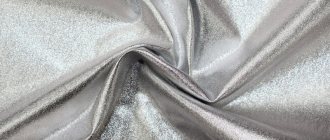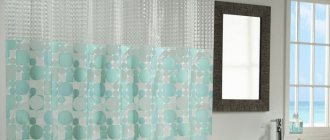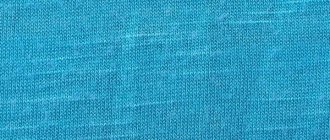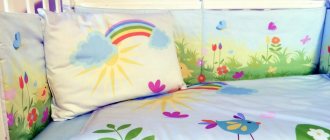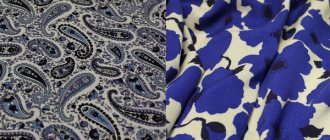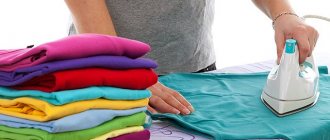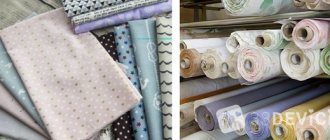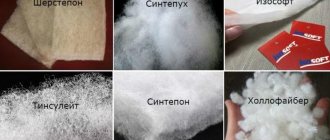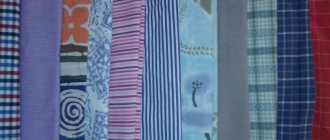Viscose
Currently, this material is widely used in the production of clothing due to the natural ingredients that are included in the composition. One of the features of viscose is its strength, as well as its bright color saturation and characteristic natural shine. The word “viscose” itself is translated from Latin as “sticky” or “viscous”.
The material is considered artificial , but this is the only case when non-natural fabric is made from natural raw materials. The history of its creation began at the end of the 19th century, when the French chemical engineer Hilaire de Chardonnay , who conducted research in the field of obtaining artificial materials, achieved the production of viscose thread. But for unknown reasons, he was unable to obtain a patent for his product. Later, when the material was patented, a factory for its production was opened. The leading areas in which viscose is used are:
- Manufacture of wearing apparel.
- Production of textiles and bed linen.
- In the production of yarn for knitting.
- In the shoe industry.
- In the manufacture of tires for cars.
- In the production of cellophane.
Summer clothes are very popular . Due to the fact that viscose is breathable and lightweight, many people love this type of fabric so much that they prefer it to many others.
The material consists mainly of cellulose, which is a fibrous compound that is present in all plants. Cellulose is also present in tree bark and celery. Certain types of viscose are made from cotton seeds, which are left over after the manufacturing process. Types of viscose fabric are distinguished by the number of fibers and thread numbers. In this regard, the parameters of creasing, heat and thickness in the finished material differ qualitatively.
What is viscose
The history of the first artificial fibers began in 1910. Through complex chemical compounds, cellulose was obtained, which became the basis of viscose fabrics. Viscose is considered the most natural fiber among all types that are created artificially . Depending on the complexity of the weaves and the thickness of the viscose threads, a variety of fabrics are obtained, very similar in their characteristics to wool, linen, cotton or silk.
The features of viscose fabric include the following:
- viscose fabrics are pleasant to the touch;
- the canvas has high hygroscopicity, moisture evaporates from its surface without hindrance;
- the material allows the skin to breathe and creates a favorable microclimate;
- Viscose is easily dyed with all kinds of dyes.
Polyester
Polyester is a completely artificial material consisting of petroleum and its derivatives. Due to the lack of natural ingredients in the composition, the most important characteristics of polyester are:
- High strength indicators.
- Low crease coefficients.
- Preservation of flowers and use of the finished product for a long time.
- Ability to maintain shape for a long time.
Due to its high performance characteristics, the scope of application of this material is very wide. In light industry, by adding fibers of other materials, it is used in almost all branches of light industry, from the production of underwear and bed linen to the manufacture of insulation and clothing for extreme conditions. The history of its creation began in the thirties of the last century, and the material itself was obtained in 1949. Initially, packaging containers were made from polyester, and only later the scope of application became wider. At the moment, in addition to the fabric version, it is produced in the form of plastic and film.
Description and composition
Polyviscose, what kind of fabric is it, natural or not? Polyviscose fabric contains a percentage of natural viscose and synthetic polyester - hence the name.
Polyester and viscose - what are these fabrics?
- Viscose is a fiber obtained from cellulose by processing wood, that is, a natural material obtained artificially.
- Polyester is a completely synthetic material obtained as a result of oil refining, its melt.
Which is better, viscose or polyester? There cannot be a definite answer here, because each material has its own pros and cons. Viscose is environmentally friendly, breathable and absorbs water, and polyester is a very strong and wear-resistant material.
Polyviscose contains viscose, polyester and, sometimes, elastane in different proportions; now we’ll figure out what kind of fabric it is.
- 70% polyester, 30% viscose - what kind of fabric is this? Depending on the manufacturing method, the material can look like silk, linen or even wool. Different types of material have several qualities in common - pleasant tactile sensations, strength and wear resistance.
- What kind of fabric is 30% viscose, 65% polyester, 5% elastane? The previous option has one, but very significant, disadvantage - it does not stretch well. Adding a small percentage of elastane allows the material to stretch well in different directions, which, in turn, sufficiently expands the range of its applications.
In general, the material can be described as follows - soft, delicate, shiny, flows and forms beautiful draperies.
Price - from 450 rubles.
What do viscose and polyester have in common?
Despite the visual similarities in certain types of viscose and polyester, these two types of fabric have little in common:
- The price of both fabric options is in the same range.
- Both types of fabric are suitable for the production of summer clothing, the hairiness in both cases is low.
- Both materials are highly durable.
It is worth noting that due to similar characteristics, viscose and polyester are often combined together in production, producing a material called polyviscose.
About polyester
Polyester production involves the use of polyester fibers that are obtained artificially. But polyester is rather a whole group of fabrics, because it can be light and thin, or durable and tough. It all depends on what the material will be used for. Interestingly, polyester is actively used not only for sewing wardrobe items, but also for tents and various accessories.
The advantages of polyester include its low wrinkleability, products made from this fabric do not need ironing, and dry quickly. Despite all the advantages of polyester, scientists still do not recommend wearing polyester all the time, because it has not yet been 100% proven whether it is harmful or not.
Viscose is often combined with polyester to create a new material whose properties depend on the percentage of these two components. It is impossible to say for sure whether viscose and polyester are good or not to wear, because the material is different from the material. However, it is best to use natural materials, the quality of which there is no reason to doubt. Even if such a product costs more, it will definitely be more pleasant to wear and will not become electrified, unlike synthetic fabrics.
Differences between polyester and viscose
When assessing the differences between polyester and viscose, it is first worth remembering how the fibers of both fabrics are produced.
| Viscose | Polyester |
| Contains natural cellulose filaments | Made entirely of polyesters |
| Visually has a pleasant shine, similar to the shine of natural silk | Made from very shiny threads, which in the fabric have too much shine |
| Pleasant and soft material to the touch | Hard material, can sometimes rub where it comes into contact with the skin |
| Good air permeability and good hygroscopicity | Does not allow air to pass through |
| Washing should be done on delicate cycles at low temperatures. | Can be washed on long cycles at high temperatures |
| Burns evenly when ignited | Correct when ignited |
| When cutting, the edge of the fabric crumbles a lot | When cutting fabric, a smooth edge is maintained |
| After washing it shrinks strongly and stretches when worn. | The sizes of clothes when worn and after washing remain unchanged |
| Wrinkles a lot | Retains its shape well after compression |
| Absorbs foreign odors | Odor resistant |
| Not electrified | Electrified |
| Recommended for wearing | Scientists have not given definitive data on the harmlessness of the material. Not recommended for regular wear |
How can you tell the difference between viscose and polyester?
Practical recommendations:
- Appearance . Viscose threads have a shine reminiscent of the natural shine of silk, while polyester fibers have an unnatural shine, a little like metal.
- To the touch . When you touch materials that contain viscose, you feel the softness of the fabric. And others do not give a feeling of softness and comfort when touching the fabric.
- Durability . Viscose, having good strength potential, still breaks under strong tension, while polyester is more resistant to tearing and abrasion.
- Hairiness . Materials containing polyester are smoother than those made from cellulose.
- Trimming . Viscose is cut smoothly and well; polyester is much more difficult to cut with scissors, since the thread has very high strength.
- Flammability . Viscose materials burn evenly, and polyester melts at high temperatures.
- Washing and care. Materials based on cellulose fibers require a more delicate attitude: they cannot be boiled or bleached. Polyester, on the contrary, is resistant to bleach and boiling.
It is difficult for a person who does not understand the intricacies of textile production to distinguish one type of fabric from another, but sometimes it is necessary to do so. After all, its price depends on what material the product is made from. How to distinguish viscose fabric from polyester is described below.
Synthetic fibers. After the appearance of artificial fabrics in the clothing industry in the first half of the last century, clothing made from them was considered fashionable and stylish. Nowadays, such characteristics of materials as environmental friendliness and comfort come to the fore. But synthetics added to the fabric can significantly increase the service life of the product; 30% synthetics in the composition is normal. Synthetic fibers may differ in composition and production method, but we must not forget that they are made from processed petroleum products. Synthetic clothing is not recommended for asthmatics, people prone to allergies and other types of skin diseases.
What is sewn from viscose and lycra?
The material is widely used in the textile industry. Used for sewing clothing items. Depending on the thickness of the threads, it imitates light linen and thick woolen products.
Despite the artificial method of obtaining fibers, viscose with lycra is similar in characteristics to natural fabrics. In this regard, things support natural air circulation and absorb moisture. Due to the combination of these qualities, clothing creates comfortable wearing conditions. The material is pleasant to the body.
Most often they sew:
- shirts, blouses;
- summer T-shirts, tank tops;
- light trousers, dresses;
- tracksuits.
Note! The fabric is suitable for creating men's, women's and children's clothing.
Description of viscose
The basis of viscose material is cellulose, which is produced in the form of a fibrous mixture. Such compounds are present in all plants, but only wood cellulose is needed to produce viscose material. In 1910, as a result of complex chemical reactions, a method was invented for processing cellulose into artificial fibers.
Until our time, the viscose production process has been modernized and has become more feasible from an economic point of view. Through complex weaves, depending on the thickness of the viscose fibers, various materials are obtained, very similar in features to silk, cotton, linen or wool. Therefore, the finished fabric is differentiated according to the degree of heat, thickness and creasing.
Thanks to the natural components present in the composition, the fabric is popular in the production of clothing.
Main characteristics:
- pleasant to the touch;
- high hygroscopicity;
- fits the figure in beautiful folds;
- hypoallergenic;
- “breathes” freely;
- paints well, bright colors predominate;
- has a natural shine reminiscent of silk;
- not durable when wet;
- easy to tighten;
- wears out quickly.
It is not recommended to wring out viscose products in a washing machine; even by hand, you need to perform this procedure carefully, wrapped in a towel. Do not iron with a hot iron.
Fact! Viscose is the only natural fiber that is created artificially.
